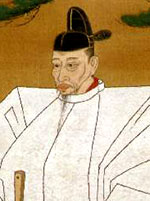Toyotomi Hideyoshi
Japan, 1536-98

Japansk kejser. Fader til bl.a. sønnen Hideyori.
- Sekigahara, 1600
- Toyotomi-borgen, 1614-15
Hidejoshi, Tojotomi (1536-98), japansk statsmand, hed oprindelig Tokisjiro og var af lav æt. Hjalp 1573 Nobunaga (s.d.) at styrte shongunen og var hans bedste feltherre. Efter Nobunagas drab 1582 fortsatte han dennes arbejde med at kue de selvrådige daimioer og omordnede og centraliserede med stor dygtighed hele Japans forvaltning, så at lenstidens ville anarki afløstes af ro og orden. Hudejoshi var en højtbegavet feltherre og statsmand, en af den japanske krigerstats store grundlæggere og Japans folkehelt fremfor alle. Hans vidtflyvende erobringsplaner medførte det mislykkede hærtog til Korea 1582. Samme år tog han titelen Taiko Sama (deraf ordet Taikun s.d.). Arvtager efter Hidejoshi blev hans forbundsfælle Ijejasu (s.d.).
Japanese warrior and dictator. He entered the service of Nobunaga as his sandal holder and rose to become his leading general. After Nobunaga's death Hideyoshi ruled as civilian dictator. He set out to unify Japan, violently disrupted by a century of civil strife. Hideyoshi subdued the military Buddhist sects, conquered Kyushu, and in 1584 came to terms with Ieyasu. By 1590, with the defeat of the Hojo clan, Hideyoshi was ruler of a united Japan. Although best remembered for his military exploits, Hideyoshi as a civil administrator decreed a land survey, revised the land tax, developed a code of maritime law, and encouraged foreign trade. He at first received Christian missionaries cordially. Then, believing them a political danger because of their proselytizing zeal, he proscribed (1587) their activities and persecuted some of them. In 1592 he attempted to conquer China but succeeded only in occupying part of Korea; just before his death he ordered withdrawal from Korea. He erected monuments, reconstructed Kyoto and Osaka, and encouraged the arts. During the last decade of his life, he ruled mainly from Kyoto, where he had a luxurious residence at Momoyama.